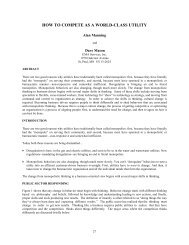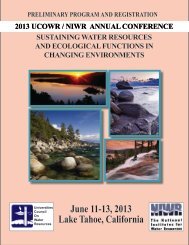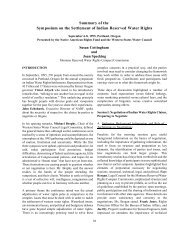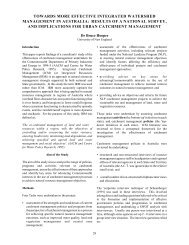Full Journal of Contemporary Water Research and Education, Issue ...
Full Journal of Contemporary Water Research and Education, Issue ...
Full Journal of Contemporary Water Research and Education, Issue ...
You also want an ePaper? Increase the reach of your titles
YUMPU automatically turns print PDFs into web optimized ePapers that Google loves.
Implementation <strong>of</strong> Australian <strong>Water</strong> Laws127found in New South Wales. A study in Queensl<strong>and</strong><strong>of</strong> stakeholders in small catchments found thatthere was little trust in the state government overnatural resources management (Rickson 2006).The CEO’s also reported low levels <strong>of</strong> trust inrelation to the relevant state government. Therewas also a massive variation between corporategovernance types, as well with statutory boards,<strong>and</strong> government-owned corporations were mosttrusting <strong>and</strong> local government least (Figure 6).In support <strong>of</strong> the above, the CEO’s also reportedthat they don’t generally feel nested in a mutuallysupportive policy environment, except in Victoria,<strong>and</strong> this related directly to the corporate governancetype <strong>of</strong> government-owned corporations (Figure 7).In relation to whether the CEOs feel that all sectors<strong>of</strong> their community underst<strong>and</strong> the viewpoints <strong>of</strong>others, the results suggest that they are neutral, sothey are not confident <strong>and</strong> this does not vary bystate or corporate governance type. Despite all theeffort to facilitate broad community involvement(Figure 2), the CEO’s see little change in themindset <strong>of</strong> the community (Figure 8).Summary <strong>and</strong> ConclusionsThere have been massive reforms <strong>of</strong> water laws,policies, <strong>and</strong> institutions over the last 12 yearsin Australia. Most reforms require partnershipsbetween Commonwealth <strong>and</strong> state agencies <strong>and</strong>also partnerships between different sectors <strong>of</strong>the community to achieve EnvironmentallySustainable Development (ESD) implementation.This paper has shown that while there has beenconsiderable effort put in by the CEO’s, thepartnerships between sectors <strong>of</strong> the community,<strong>and</strong> between them <strong>and</strong> state governments, areimpaired by a lack <strong>of</strong> trust <strong>and</strong> a perception that thewater policies are not mutually supportive. Many<strong>of</strong> them are also puzzled as to how to achieve ESD<strong>and</strong>, with acute differences between the states indefinitions, there is a limited scope to learn fromeach other. Finally, the CEO’s still think that sectors<strong>of</strong> their community don’t underst<strong>and</strong> each other.However, the water reform is relatively new <strong>and</strong>Figure 6. Qu. 91- There is a huge amount <strong>of</strong> trust between this organization <strong>and</strong> the state government.Source: 183 CEO Surveys CRC-IF 2006JOURNAL OF CONTEMPORARY WATER RESEARCH & EDUCATIONUCOWR








